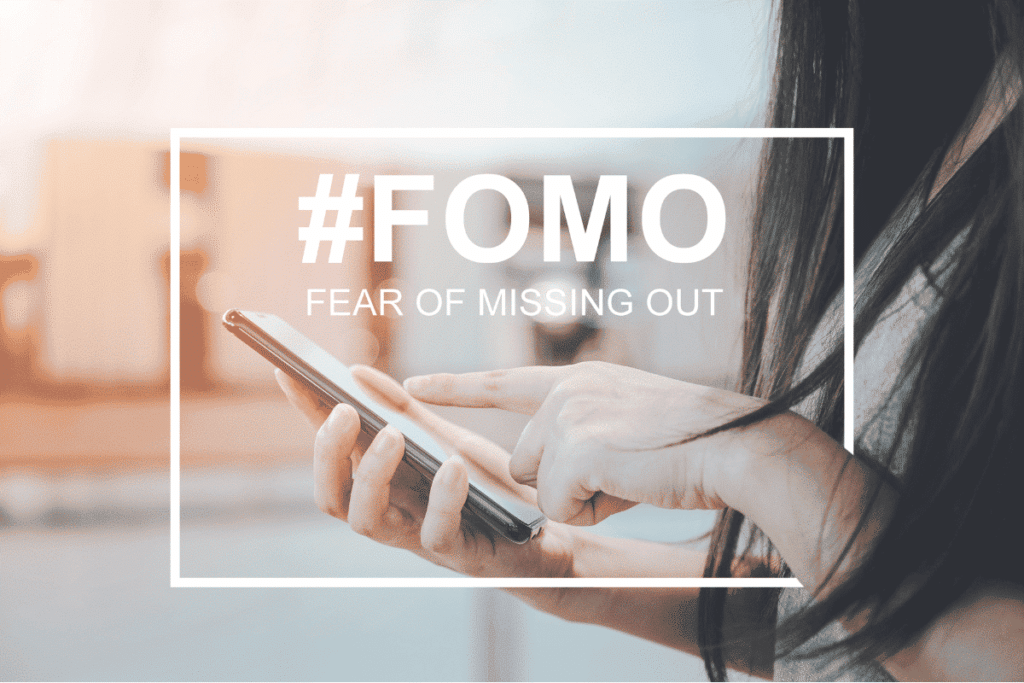Social Media and FOMO
The fear of missing out, or FOMO, drives social media users to check their notifications constantly, leading to problematic social media use and causing them to miss out on real-life relationships and meaningful activities.

 Written and edited by our team of expert legal content writers and reviewed and approved by Attorney Matthew Bergman
Written and edited by our team of expert legal content writers and reviewed and approved by Attorney Matthew Bergman
- Content last updated on:
- August 14, 2025
Written and edited by our team of expert legal content writers and reviewed and approved by

- Content last updated on:
- August 14, 2025
FOMO was once a popular marketing term that stands for “fear of missing out.” For advertisers, FOMO means persuading consumers that they will miss out on something good if they fail to purchase a product.
However, witht the increasecd use of social media, FOMO is impacting people’s mental health in ways we didn’t see in the past. Social media platforms have started using FOMO to not only lure users to their platforms but also compel them to visit the platform persistently throughout the day, even at the cost of other commitments.
Research published in Computers in Human Behavior refer to FOMO as “a pervasive apprehension that others might be having rewarding experiences from which one is absent.”
The primary characteristic of FOMO — the need to stay connected to others at all time — leads to some of the most detrimental effects of social media.
Social media platforms make their profits from advertising revenue. Every time a user sees an ad, the platforms make money. The longer users stay on the platforms and the more often they check back, the more ads they see and the more revenue the platforms generate.
Who experiences social media FOMO?
The tactics used by social media platforms are particularly effective on tweens, teens, and young adults; groups that have a greater tendency to compare themselves to others.
FOMO is a global phenomenon observed in North America, Asia, Europe, and Australia.
Research compiled by Statista has revealed the following:
- United States – By 2013, 56 percent of all social media users experienced FOMO
- Poland – 59 percent of 15- to 19-year-olds in Poland reported experiencing FOMO in 2021
- Italy – 67 percent of Italian social media users experienced FOMO in 2017
Although FOMO predates social media, the term is now almost exclusively used in conjunction with social media.

What are social media users afraid of missing?
According to experts, the compulsion to constantly check social media stems from fears associated with specific functions of social media, including the ability to share photos and video, communicate with others, and create groups — among others.
- Missing out on an opportunity to meet up with friends
- Friends having more rewarding experiences
- Being left out of inside jokes
- Being out of the loop during vacations or summer camp
- Others losing interest
- Missing important posts or messages due to too many messages or disappearing messages
- Others feeling let down or ignored when you do not respond immediately to posts
- Being left out of discussions about social media posts
- Missing requests
- Not knowing what others are doing
- Missing live chats
- Losing influence, popularity, or status
- Being mentioned in group discussions
What causes FOMO?
FOMO is a driving force that is difficult to overcome due to the deep psychosocial roots of the phenomenon.
The Need to Belong
Research suggests that FOMO stems from a desire to avoid loneliness by forming interpersonal attachments. This desire is grounded in the need to belong. Teens commonly view social media as an extension of the self, in some cases to the point that their social media identity becomes the most important concept of self.
The vast amount of activity on social media fosters a sense that something important could happen at any moment, necessitating that attention be paid to the constant stream of notifications.
FOMO stems from the belief that a user’s social standing is everything, and this standing is so delicate that it only takes one missed notification to destroy it.
Self-Comparison
While self-comparison is a natural human trait, teens tend to take it to the extreme, resulting in a need to constantly check that their appearance and lifestyles compare favorably with their peers. Unfortunately, social media platforms like Instagram encourage users to portray themselves and their lives as perfect.
The need to measure up can compel teens to engage in risky behavior to capture photographs that will impress social media followers and create an appearance that their lives are enviable. They can also apply filters to improve their physical appearance.
Despite the fact that many of the images on Instagram are inaccurate, teens tend to compare themselves with these images, resulting in negative thoughts about themselves.
They may resort to extreme measures to boost their self-esteem and constantly check Instagram to ensure the standards have not changed or that they measure up. Common extreme behaviors include the following:
- Developing eating disorders
- Working out to excess
- Taking high risks to obtain a photo

The Vicious Cycle
Anxiety about missing out prompts more frequent checking, more frequent checking increases awareness of events being missed, and awareness of missed events increases anxiety. This increases the compulsion to continuously check social media and perpetuates the cycle.
This cycle makes the fear of missing out a self-fulfilling prophecy. The process of constantly checking social media causes users with FOMO to miss out on the activities in real life that would contribute to a heightened sense of satisfaction and belonging.
Social Media Features
Certain social media features precipitate the development of FOMO in susceptible teens.
Snapchat Streaks
Snapchat streaks are created when users interact with each other for three consecutive days. Snapchat uses a scoring system based in part on the length and number of streaks a user has.
If one user fails to interact on a given day, the streak is ended. Many users end up with an overwhelming number of streaks and fear letting other users down by failing to respond on a given day.
Disappearing Posts
Snapchat, Instagram, and Facebook provide a means for users to create posts that disappear within a certain number of minutes or hours. Users who are not online before the posts disappear cannot view them in their feed later. This creates pressure to stay online.
Tagging
Tagging allows social media users to tag other users. This results in a notification being sent to the user and the user’s profile becoming accessible through a click. Tags are not always positive, but they can sometimes be removed. However, the fear of being tagged in a negative light can drive users to continuously check.
Real-Time Notifications
Notifications occur for every small event that occurs on social media. Users receive notifications when someone they follow posts an update, when they are tagged, when they receive a private message, when someone posts in a group they belong to, and more. These can be never-ending, and many users cannot resist checking them as they receive them.

What are the effects of FOMO?
FOMO is a form of anxiety that cannot be turned off through mere distraction. It makes social media the highest priority and permeates every activity.
Rather than making users feel more connected to others, social media tends to have the opposite effect.
Social media users with FOMO may experience:
- Distractibility
- Decline in productivity
- Sleep disturbances
- Social anxiety
- Clinical depression
- Decline in academic performance
- Envy
- Jealousy
- Resentment
- Overall anxiety
- Phubbing (snubbing others in real life in favor of checking smartphone notifications)
- Social media addiction
Although minor mental health problems may be a predictor of developing FOMO, serious mental health disorders can be triggered by FOMO due to its likelihood of evolving into problematic social media use.
Problematic social media use can lead to social media addiction, which triggers the reward centers of the brain every time the user experiences positive feedback from social media. This adds a physical dimension to social media use that mimics brain processes found in individuals addicted to substances.
FOMO Risk Factors
The Center for Sociological Research has identified three unmet needs that contribute to an individual’s risk of developing FOMO:
- Competence to participate in the world
- Personal independence
- Feelings of social connectedness
Surprisingly, this research found that children from intact families with healthy parental relationships were more likely to develop FOMO than children from non-intact families. Researchers attribute this to the tendency of children from non-intact families to be more self-reliant and connected to resources.
However, the research did find that a strong relationship with parents, especially the father, seems to be a protective factor.
Children with FOMO tend to lack self-confidence in real-life situations and are more likely to be unhappy and lack social contentment.

Can FOMO be prevented?
Social media has become an integral part of modern-day culture, and keeping children off of social media is a battle most parents cannot win. However, parents can take an active role in their children’s social media participation to ensure it does not become problematic.
The most proactive approach parents can take is to become educated about every aspect of social media, including how to use the platforms your children are using, the effects and warning signs of problematic social media usage, and where to turn for help.
The American Academy of Pediatrics provides a recommended Family Media Use Plan that can help parents set appropriate limits for social media use in the household. The most important elements are as follows:
- Keep screens out of bedrooms
- Don’t allow screens at mealtime
- Limit entertainment screen time to two hours daily
- Restrict children and teens from viewing content that is not age-appropriate
How can I help my teen overcome social media-related FOMO?
Preventing FOMO or helping a teen overcome it can be challenging for parents because teens often resist their help. However, it is crucial to help your teen develop healthy and satisfying offline relationships and hobbies. Increasing overall satisfaction with life in the offline world can at least reduce the risks.
If your teen has developed FOMO, they will need support in developing techniques to overcome it.
Techniques to Combat FOMO:
- Use self-talk to resist the urge to check
- Work on self-esteem
- Manage expectations
- Use offline activities as a distraction
- Ask themselves what they would say to a friend in the same situation
- Think before posting
- Set filters to screen out unimportant message notifications
- Set priority lists
- Mute notifications
- Set status to busy
If your teen’s FOMO has already led to social media addiction, outside intervention may be required.
As a parent, you may feel the urge to blame yourself for your teen’s FOMO, but the fault lies with the social media companies. Social media has become a force in society that even the best parenting in the world cannot overcome.
If your child has been harmed by social media, the Social Media Victims Law Center can help you hold these companies accountable. Contact us today for a free case review.
Frequently Asked Questions
For individuals and children who have been
We only handle cases on a contingent fee basis. This means that we are paid a portion of any recovery obtained in the case and you do not owe us any attorneys’ fees if the lawsuit does not result in a recovery.
Every case is unique. Our attorneys will work with your family to evaluate your potential case and help you evaluate whether filing a lawsuit or other legal proceeding is in your family’s best interest. Generally speaking, the types of cases we handle involve serious mental health effects, including attempted or completed suicide, eating disorders, inpatient mental health treatment, or sexual trafficking/exploitation that was caused by or contributed to through addictive or problematic social media use by teens and young adults.
We are a law firm based near Seattle, WA comprised of lawyers who have spent their entire careers representing victims who have been harmed by dangerous products. We are also parents. Shocked and troubled by the recent revelations about the harm caused to teens and young adults by social media platforms, which powerful technology companies have designed to be highly addictive, Social Media Victims Law Center was launched specifically to help families and children who have suffered serious mental harm or exploitation through social media use to obtain justice.
Contact Us Today
Related Pages
Client Testimonials
Is Your Child Addicted to Social Media?
You Are Not Alone.
We have helped hundreds of families just like yours whose children and teens were affected by social media addiction.
Explore Popular Topics

Addiction

Suicide

Eating Disorders

Anxiety

Bullying

Sexual Abuse

Body Image


